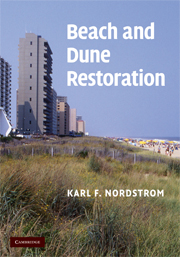Book contents
- Frontmatter
- Contents
- Preface
- Acknowledgments
- 1 The need for restoration
- 2 Beach nourishment and impacts
- 3 Dune building practices and impacts
- 4 Restoring processes, structure, and functions
- 5 Options in spatially restricted environments
- 6 A locally based program for beach and dune restoration
- 7 Stakeholder interests, conflicts, and co-operation
- 8 Research needs
- References
- Index
5 - Options in spatially restricted environments
Published online by Cambridge University Press: 14 August 2009
- Frontmatter
- Contents
- Preface
- Acknowledgments
- 1 The need for restoration
- 2 Beach nourishment and impacts
- 3 Dune building practices and impacts
- 4 Restoring processes, structure, and functions
- 5 Options in spatially restricted environments
- 6 A locally based program for beach and dune restoration
- 7 Stakeholder interests, conflicts, and co-operation
- 8 Research needs
- References
- Index
Summary
Alternative restoration outcomes
Coastal environments should be managed as large units, taking adjacent areas into account (van der Meulen and Salman 1995), but restoration of full geomorphological and ecological gradients across the shore may be impossible because of spatial restrictions and fragmentation of habitats caused by humans (Rhind and Jones 1999; Doody 2001; Freestone and Nordstrom 2001; Pethick 2001). Abiotic thresholds, physical barriers, and disturbances create boundaries between adjacent ecological systems in nature (Gosz 1991; Johnstone et al. 1992; Risser 1995). Human impacts often sharpen these boundaries (Correll 1991), segment them by land-use or ownership (Forman 1995), halt natural flows across them (Harris and Scheck 1991), and create new flows (Bennett 1991). Given the ever-increasing pace and scale of human inputs, it is crucial to identify the way natural habitats can be accommodated in environmental gradients that are truncated, compressed, decoupled, or fragmented. The on-going conversion of natural landscapes to human use places increased emphasis on maximizing use of remaining undeveloped enclaves and converting developed holdings to natural environments. Conversion of vast tracts of intensively altered landscapes back to naturally functioning ones may be unlikely, but phased restoration of smaller tracts is possible and can be advantageous in the short term to address local problems with sediment budgets and flood risks and long-term changes in thinking about the value of natural landforms and habitats and adaptive policies (Pethick 2001).
- Type
- Chapter
- Information
- Beach and Dune Restoration , pp. 94 - 106Publisher: Cambridge University PressPrint publication year: 2008



